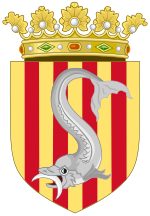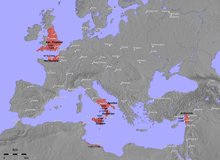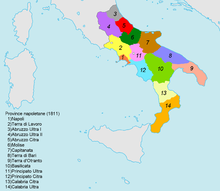Terra d'Otranto
Terra d'Otranto (also: Terra di Otranto; Land of Otranto ) was an old administrative unit (Italian: Giustizierato; plural: Giustizierati) in southern Italy , which existed from 1231 to 1860/61 and first became part of the Kingdom of Sicily , then to the Kingdom of Naples , belonged to the Kingdom of the Two Sicilies and later to the Kingdom of Italy . In 1927 the area was finally dissolved. Today it belongs to Apulia and is located in the lowlands of the provinces of Lecce , Brindisi and up to Massafra to the province of Taranto .
location
After 1663, the Terra d'Otranto extended about 140 km from the Messapian threshold and the Itria Valley in the north to Santa Maria di Leuca in the south and on average about 40 km between the Gulf of Taranto in the west and the Strait of Otranto in the East.
In the north, the area bordered the historic Terra di Bari region , in the west on the administrative unit of Basilicata , in the south on the Ionian Sea and in the east on the Adriatic , practically the entire Salento peninsula , a considerable part of the Murgia of the Trulli , (a plateau in Apulia ; known as the Itria Valley) and part of the Alta Murgia that slopes down towards the Ionian Sea.
coat of arms
The coat of arms of the Terra d'Otranto shows a wriggling silver dolphin with the Islamic crescent moon , the symbol of the Ottoman Empire , in its mouth . Alfonso of Aragon , son of the King of Naples , Ferdinand I , had the crescent moon added in 1481, one year after the Otranto campaign and the expulsion of the Ottomans.
history
The administrative unit "Giustizierato Terra d'Otranto"
Since the 11th century, the areas of today's provinces of Lecce , Tarent and Brindisi (except Fasano and Cisternino ) and the area around Matera have been an integral part of the Terra d'Otranto. Under the Spanish viceroy of Naples Gaspar de Bracamonte y Guzmán , Matera was declared the capital of the Giustizierato Basilicata by decree in 1663.
Terra d'Otranto was of great importance in ancient times and in the early Middle Ages and was the seat of the Byzantine government, from whose time this name comes. During the Norman conquest of the Hauteville in southern Italy , the county of Lecce was established in 1055 and the principality of Taranto in 1088 . Under the Staufer Friedrich II , Puglia was divided into three Giustizierati Capitanata , Terra di Bari and Terra d'Otranto, the latter of which was one of the southernmost. This administrative organization was maintained during the Kingdom of Sicily and the later Kingdom of Naples.
The first capital was Otranto, which lost its importance in the late 12th century; However, retained the archbishop's prestige obtained in the 11th century.
Lecce , located in the "heart of the Salento", became an increasingly important administrative center, but remained a subordinate diocese of Otranto. Under the French rulers of the House of Anjou and then those of the Spanish Habsburgs , Lecce became the undisputed political and administrative administrative center of the Terra d'Otranto, one of the richest and most cultural cities in the Mediterranean.
The province of Terra d'Otranto
With the royal decree No. 132 of August 8, 1806 on the "divisione ed amministrazione delle province del Regno" (division and administration of the provinces of the empire), the then King of Naples, Joseph Bonaparte , reformed the territorial division of the kingdom on the basis of the French model and abolished the Giustizierati system. The law divided the kingdom into thirteen provinces ( Provincie ), each with its own capital. The provinces were further divided into districts ( Distretti ) and counties ( Circondari ), each with a capital. The province of Terra d'Otranto was divided into three districts (Lecce, Taranto, Mesagne ). The capital of the province was Lecce. With the administrative royal decree " per la nuova circoscrizione delle quattordici provincie del Regno di Napoli " (for the new description of the 14 provinces of the Kingdom of Naples) No. 922 of May 4, 1811, the provinces of the Kingdom of Naples were divided into districts, districts and Municipalities ( Comuni ) divided. There were no major changes for the province of Terra d'Otranto.
With the administrative decree "per la formazione di un quarto distretto nella provincia di Terra d'Otranto" (for the formation of a 4th district in the province of Terra d'Otranto) No. 1697 of April 21, 1813, issued by Joachim Murat , the province of Terra d'Otranto received its 4th district Gallipoli from January 1, 1814 . In addition, the Mesagne district was renamed the Brindisi district. With Decree No. 360 of May 1, 1816, issued by Ferdinand I , the number of provinces was increased to 15 and the "Comuni" was divided into three categories:
- The first class comprised the municipalities with a population of at least 6,000, where there was an administrative office , an appeals court or a criminal court, and those with a regular income of 5,000 ducats .
- The second class comprised the municipalities with a population between 3,000 and 6,000 and those where there was a sub-management.
- The third class consisted of communities with fewer than 3,000 inhabitants.
Administrative law no. 570 of December 12, 1816 “ sull'amministrazione civile ” (on the civil service) retained the Napoleonic model with some changes.
The dissolution of the province of Terra d'Otranto
After the unification of Italy in 1861, the province of Terra d'Otranto was also called "Terra di Lecce" and divided into four "Circondari" (Lecce, Gallipoli, Brindisi, Taranto).
During the 20th century, the area of the historical province was dissolved in 1923 with the establishment of the Provincia del Ionio (Ionian Province) and in 1927 with the Province of Brindisi .
literature
- Giacomo Arditi: La corografia fisica e storica della provincia di terra d'Otranto . Ammirato Scipione, Lecce 1879 (Italian).
- F. Antonio Primaldo Coco: Gli albanesi in Terra d'Otranto in: Japigia (Rivista di archeologia, storia e arte) Ser. NS, vol. 10 . Bari 1939, p. 329-341 (Italian).
- Gabriello De Sanctis: Dizionario statistico de 'paesi del regno delle Due Sicilie . Naples 1840 (Italian, online version in Google Book Search).
- Johann Georg Hager : From the globe and Europe in general, from Portugal, Spain, France, Great Britain, the Netherlands, Switzerland and Italy in particular. 1st part . Chemnitz 1746, p. 1049 ( online version in Google Book Search).
- Wilhelm Hoffmann: Description of the earth, according to its natural composition, its products, inhabitants and their effects and conditions as they are now, Volume 2, Issue 1 . Swiss beard, Stuttgart 1834, p. 911 ( online version in Google Book Search).
Individual evidence
- ^ Giacomo C. Bascapè, Marcello Del Piazzo: Araldica Napoleonica in Italia in: Insegne e simboli: araldica pubblica e privata medievale e moderna . Ministero per i beni e le attività culturali - Ufficio centrale per i beni archivistici, Rome 1999, ISBN 88-7125-159-8 , p. 893 (Italian). '
- ^ Scipione Mazzella: Descrittione del Regno di Napoli . Giovan Battista Cappello, Naples 1601, p. 188 (Italian, online version in Google Book Search).
- ↑ Luca Iaccarino: Puglia e Basilicata . Edt, Turin 2011, ISBN 978-88-6040-798-6 , pp. 27 (Italian, online version in Google Book Search).
- ↑ Terra d'Otranto in: Treccani.it
- ^ Albert Sleumer: Church Latin Dictionary . Georg Olms Verlag, Hildesheim 2015, ISBN 978-3-487-09374-1 , p. 394 ( online version in Google Book Search).
- ↑ Lecce. Zeno.org, accessed March 5, 2017 .
- ↑ a b (N ° 132) Legge sulla divisione ed amministrazione delle provincie del regno. Bicentenario.provincia.napoli.it, accessed March 5, 2017 (Italian).
- ↑ Comune, Regno di Napoli, 1806 - 1815. Archivi.beniculturali.it, accessed on March 5, 2017 (Italian).
- ^ Bullettino delle leggi del Regno di Napoli (Bulletin of the Laws of the Kingdom of Naples) . Fonderia Reale, Naples 1811, p. 139 (Italian, online version in Google Book Search).
- ^ Bullettino delle leggi del Regno di Napoli (Bulletin of the Laws of the Kingdom of Naples) . Fonderia Reale, Naples 1811, p. 274 (Italian, online version in Google Book Search).
- ^ Bullettino delle leggi del Regno di Napoli (Bulletin of the Laws of the Kingdom of Naples) . Fonderia Reale, Naples 1813, p. XVII (Italian, online version in Google Book Search).
- ↑ Comune di Oria. Archivi.beniculturali.it, accessed March 6, 2017 (Italian).
- ^ Comune, Regno delle Due Sicilie, 1816 - 1860 (municipality, Kingdom of the Two Sicilies, 1816 - 1860). Retrieved March 7, 2017 (Italian).
- ^ Domini al di qua del Faro (Italia meridionale). Guida generale degli Archivi di Stato italiani, accessed March 6, 2017 (Italian).
- ↑ Royal Decree No. 1911 of September 2, 1923 on the Istituzione della provincia di Taranto (establishment of the Province of Taranto). Wikisource.org, accessed March 7, 2017 (Italian).
Remarks
- ↑ Giurisdizione del giustiziere, e Luogo, dove s'abbia autorità d'esercitare la giustizia (jurisdiction of the judge and the place where one is authorized to exercise the law)
- ↑ "Pali vermigli in campo d'oro, sopra i quali un delfino d'argento con mezza luna in bocca."
- ↑ "... Fa per insegna questa Regione quattro pali vermigli per lungo in campo d'oro, sopra de 'quali è posto un Delfino stizzoso, che tiene in bocca una mezza Luna. L'origine della quale arme fu posta in uso l'anno 1481, al tempo che Alfonso d'Aragona Duca di Calavria figliuolo di Ferdinando I Re di Napoli discacciò i Turchi dalla città d'Otranto, e dagli altri luoghi; onde volendo gli huomini di questa Provintia mostrare il grandissimo servitio, che 'l suo Re fatto haveva loro in liberarli dalle mani dell'empio tiranno Maumet II Re de Turchi, per questo fecero la già dett'insegna, mostrando per li quattro pali vermigli campo d'oro l'arme del Re Ferd. D'Aragona. Il Delfino non fu cosa inventata, già che anticamente, per quanto le medaglie chiariscono, il Delfino con Nettuno erano proprie insegne del paese de 'Salentini. Ma v'aggiunsero solamente la meza Luna in bocca del Delfino. Volendo dinotare, che la nuova Signoria, che 'l tiranno Maumet s'haveva ingegnato d'occupare di sì bella Regione, gli fu per la sollecitudine del valoroso Alfonso, e virtù de' proprii habitanti, tolta .... "
- ↑ Ferdinand was King of Naples as Ferdinand IV from October 6, 1759 to January 23, 1799; June 13, 1799 to March 30, 1806; May 22, 1815 to December 12, 1816; as Ferdinand III. King of Sicily from October 6, 1759 to December 12, 1816 and, as Ferdinand I, King of the Two Sicilies from December 12, 1816 to January 4, 1825.
Web links
- Terra d'Otranto. Treccani.it, accessed March 4, 2017 (Italian).
- Giustizierato. Lessicografia.it, accessed March 5, 2017 (Italian).



